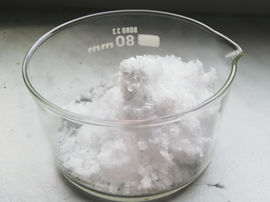Barium hydroxide
 Barium hydroxide octahydrate
| |
| Names | |
|---|---|
| IUPAC name
Barium hydroxide
| |
| Other names
Barium dihydroxide
Baryta Baryta-water | |
| Properties | |
| Ba(OH)2 (anhydrous) Ba(OH)2·H2O (monohydrate) Ba(OH)2·8H2O (octahydrate) | |
| Molar mass | 171.34 g/mol (anhydrous) 189.355 g/mol (monohydrate) 315.46 g/mol (octahydrate) |
| Appearance | White solid |
| Odor | Odorless |
| Density | 4.5 g/cm3 (20 °C) (anhydrous) 3.743 g/cm3 (monohydrate) 2.18 g/cm3 (25 °C) (octahydrate) |
| Melting point | octahydrate 78 °C (172 °F; 351 K) monohydrate 300 °C (572 °F; 573 K) anhydrous 407 °C (765 °F; 680 K) |
| Boiling point | 780–800 °C (1,440–1,470 °F; 1,050–1,070 K) Decomposes |
| 1.67 g/100 ml (0 °C) 2.48 g/100 ml (10 °C) 3.89 g/100 ml (20 °C) 5.59 g/100 ml (30 °C) 8.22 g/100 ml (40 °C) 13.1 g/100 ml (50 °C) 20.9 g/100 ml (60 °C) 101.4 g/100 ml (80 °C)[1] | |
| Solubility | Reacts with acids Insoluble in hydrocarbons |
| Vapor pressure | ~0 mmHg |
| Thermochemistry | |
| Std molar
entropy (S |
124 J·mol-1·K-1 |
| Std enthalpy of
formation (ΔfH |
−944.7 kJ/mol |
| Hazards | |
| Safety data sheet | Sigma-Aldrich (octahydrate) |
| Flash point | Non-flammable |
| Lethal dose or concentration (LD, LC): | |
| LD50 (Median dose)
|
308 mg/kg (rat, oral) 255 mg/kg (rat, IP) |
| Related compounds | |
| Related compounds
|
Magnesium hydroxide Calcium hydroxide Strontium hydroxide |
| Except where otherwise noted, data are given for materials in their standard state (at 25 °C [77 °F], 100 kPa). | |
| Infobox references | |
Barium hydroxide is a chemical compound with the chemical formula Ba(OH)2. The monohydrate (x = 1), known as baryta or baryta-water, is one of the principal compounds of barium.
Contents
Properties
Chemical
Barium hydroxide decomposes to barium oxide when heated to 800 °C.
- Ba(OH)2 → BaO + H2O
Reactions of barium hydroxide with ammonium salts are strongly endothermic. The reaction of barium hydroxide octahydrate with ammonium chloride or ammonium thiocyanate is often used as a classroom chemistry demonstration, producing temperatures cold enough to freeze water and enough water to dissolve the resulting mixture.
Barium hydroxide is occasionally used in organic synthesis as a strong base, for example for the hydrolysis of esters and nitriles, and as a base in aldol condensations. It can be used to perform decarboxylation of amino acids.
Barium hydroxide is often used in ketonic decarboxylations for the preparation of various organic compound, like cyclopentanone from adipic acid[2] or in aldol reactions like in the preparation of diacetone alcohol from acetone.[3]
Physical
Barium hydroxide is a colorless solid, slightly soluble in cold water, but more soluble in hot water.
As barium carbonate is insoluble in water, clear solutions of barium hydroxide are free of any carbonates (but they go turbid quickly as they absorb carbon dioxide from the air). This property allows the use of barium hydroxide to be used in titration of acids using indicators such as phenolphthalein or thymolphthalein (with alkaline color changes) without the risk of titration errors due to the presence of carbonate ions, which are much less basic.
Availability
Barium hydroxide is sold by chemical suppliers.
Preparation
Barium hydroxide can be prepared by dissolving barium oxide (BaO) in water:
- BaO + H2O → Ba(OH)2
The reaction is exothermic, and the heat produced may even melt the octahydrate.
It crystallizes as the octahydrate from water, which converts to the monohydrate upon heating in air above 78 °C.
If heated above 100 °C in a vacuum, the monohydrate will yield BaO and water.[4][5]
A simple route involves the double displacement of barium chloride with sodium hydroxide. Both solutions should be warmed before being mixed and hot filtered to remove small amounts of barium carbonate.
- BaCl2 + 2 NaOH + 8 H2O → 2 NaCl + Ba(OH)2·8H2O ↓
Another possible preparation route, taking advantage of its moderate water solubility, involves the double displacement reaction of barium acetate and potassium hydroxide, reaction which takes place at high temperatures (60-80 °C). As the solution cools, the less soluble barium hydroxide precipitates out of the solution, while the much more soluble potassium acetate stays in solution.
- Ba(CH3COO)2 + 2 KOH + 8 H2O → 2 CH3COOK + Ba(OH)2·8H2O ↓
Projects
- Make barium salts
- Titration of acids
- Chemical demonstrations of endothermic reactions
- Ketonic decarboxylations
Handling
Safety
Barium hydroxide is toxic if ingested, as it reacts with stomach acid to form the more soluble barium chloride. In case of ingestion, a non-toxic soluble sulfate solution (like sodium or magnesium sulfate) can be used as antidote.
Storage
Should be kept in air-tight plastic bottles.
Disposal
Can be mixed with a sulfate, to yield the insoluble barium sulfate, which is non-toxic.
References
- ↑ Rabinovich V.A., Khavin Z.Ya. Brief chemical reference book. - L.: Chemistry, 1977 (Рабинович В.А., Хавин З.Я. Краткий химический справочник. - Л.: Химия, 1977). Data retrieved from http://chemister.ru/Database/properties-en.php?dbid=1&id=375
- ↑ M. Renz, Eur. J. Org. Chem. 2005, 6, 979-988. doi:10.1002/ejoc.200400546
- ↑ J. B. Conant, N. Tuttle. Org. Synth. 1921, 1, 45, doi:10.15227/orgsyn.001.0045
- ↑ R. P. Seward, J. Am. Chem. Soc. 1945, 67, 7, 1189–1191, doi:10.1021/ja01223a049
- ↑ Gmelins Handbuch der anorganischen Chemie, Barium, Ergänzungsband, 8th edition 1960, Weinheim, Verlag Chemie, p. 289.